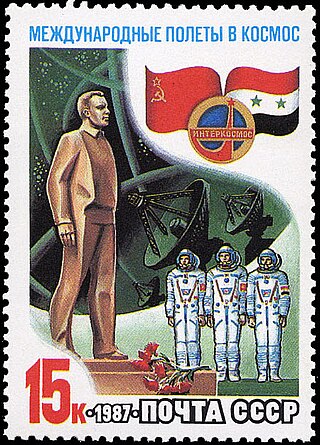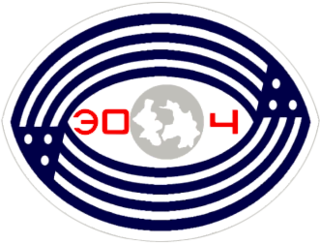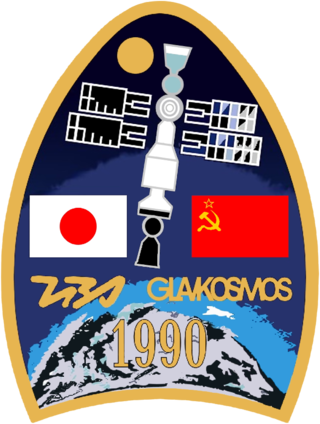
Mir was a space station that operated in low Earth orbit from 1986 to 2001, operated by the Soviet Union and later by Russia. Mir was the first modular space station and was assembled in orbit from 1986 to 1996. It had a greater mass than any previous spacecraft. At the time it was the largest artificial satellite in orbit, succeeded by the International Space Station (ISS) after Mir's orbit decayed. The station served as a microgravity research laboratory in which crews conducted experiments in biology, human biology, physics, astronomy, meteorology, and spacecraft systems with a goal of developing technologies required for permanent occupation of space.

Anatoly Yakovlevich Solovyev is a retired Russian and Soviet cosmonaut and pilot. Solovyev was born on January 16, 1948, in Riga, Latvia. Solovyev holds the world record on the number of spacewalks performed (16), and accumulated time spent spacewalking.

Vladimir Georgiyevich Titov is a retired Russian Air Force Colonel and former cosmonaut. He has participated in four spaceflight missions. The catastrophic explosion of a Soyuz rocket in 1983 led to him being one of only four people to use a launch escape system. He is married to Alexandra Kozlova, they have two children.

Yury Vladimirovich Usachov is a former cosmonaut who resides in Star City, Moscow. Usachov is a veteran of four spaceflights, including two long-duration missions on board the Mir Space Station and another on board the International Space Station. During his career, he also conducted seven spacewalks before his retirement on April 5, 2004.

Soyuz TM-2 was a crewed spaceflight to the Soviet space station Mir, which was uncrewed at the time. TM-2 was launched on February 5, 1987, and it was first crewed spaceflight of the Soyuz-TM spacecraft, and the second crewed spaceflight to Mir. The crew of the long duration expedition, Mir EO-2, who were launched by TM-2 consisted of Soviet cosmonauts Yuri Romanenko and Aleksandr Laveykin.

Soyuz TM-3 was the third crewed spaceflight to visit the Soviet space station Mir, following Soyuz T-15 and Soyuz TM-2. It was launched in July 1987, during the long duration expedition Mir EO-2, and acted as a lifeboat for the second segment of that expedition. There were three people aboard the spacecraft at launch, including the two man crew of the week-long mission Mir EP-1, consisting of Soviet cosmonaut Aleksandr Viktorenko and Syrian Muhammed Faris. Faris was the first Syrian to travel to space, and as of June 2021, the only one. The third cosmonaut launched was Aleksandr Aleksandrov, who would replace one of the long duration crew members Aleksandr Laveykin of Mir EO-2. Laveykin had been diagnosed by ground-based doctors to have minor heart problems, so he returned to Earth with the EP-1 crew in Soyuz TM-2.

Soyuz TM-4 was a crewed Soyuz spaceflight to Mir. It was launched on 21 December 1987, and carried the first two crew members of the third long duration expedition, Mir EO-3. These crew members, Vladimir Titov and Musa Manarov, would stay in space for just under 366 days, setting a new spaceflight record. The third astronaut launched by Soyuz TM-4 was Anatoli Levchenko, who returned to Earth about a week later with the remaining crew of Mir EO-2. Levchenko was a prospective pilot for the Soviet Space shuttle Buran. The purpose of his mission, named Mir LII-1, was to familiarize him with spaceflight.

Soyuz TM-5 was a crewed Soyuz spaceflight to Mir. It was launched on June 7, 1988, carrying the Mir EP-2 mission's three-person crew. This week-long stay on Mir occurred during the third long-duration Mir expedition, Mir EO-3. The crew of EP-2 returned to Earth aboard Soyuz TM-4, while the TM-5 spacecraft remained docked to Mir, acting as the lifeboat for the long-duration crew. On September 7, 1988, the TM-5 spacecraft undocked from Mir, and landed Mir EP-3 mission's two-person visiting crew. The de-orbit procedures for Soyuz were revised after this flight, as multiple issues almost prevented the descent module's safe de-orbit and landing.

Soyuz TM-6 was a crewed Soyuz spaceflight to Mir. It was launched on 29 August 1988, at 04:23:11 UTC, for the station's third long-duration expedition, Mir EO-3. The three-person crew that was launched consisted of Research Doctor Valeri Polyakov, who became part of the EO-3 crew, as well as the two crew members of the week-long mission Mir EP-3, which included the first ever Afghan cosmonaut, Abdul Ahad Mohmand.

Soyuz TM-7 was a crewed Soyuz spaceflight to Mir. It launched on 26 November 1988, at 15:49:34, and was the start of the fourth long duration expedition to Mir, Mir EO-4. The crew would join the third crew member of EO-4, cosmonaut/physician Valeri Polyakov, who was on Mir for the second half of EO-3. Also launched by Soyuz TM-7 was French astronaut Jean-Loup Chrétien, who would take part in the 24-day French mission known as Mir Aragatz. The spacecraft Soyuz TM-7 remained docked to Mir for the duration of EO-4. At the end of EO-4 in April 1989, due to delays in the launch schedule, Mir was left uncrewed, and all three EO-4 crew members were transported back to Earth.

Aleksandr Panayotov Aleksandrov is a retired Bulgarian cosmonaut. He is the second Bulgarian to have flown to space, behind Georgi Ivanov.
The Bulgarian cosmonaut program refers to human spaceflight efforts by the People's Republic of Bulgaria. The idea of a Bulgarian crewed space mission predated the launch of Sputnik 1, the first artificial satellite. An informal proposal for the Soviet Union to send a Bulgarian cosmonaut in space was issued in 1964, but it was not seriously considered by the Soviets. Official space cooperation began in 1966 with the establishment of the Interkosmos programme which allowed Communist Bloc countries to access Soviet space technology and assets.

Mir EO-4 was the fourth long-duration expedition to the Soviet space station Mir. The expedition began in November 1988, when crew members Commander Aleksandr Volkov and Flight Engineer Sergei Krikalev arrived at the station via the spacecraft Soyuz TM-7. The third crew member of EO-4, Valeri Polyakov, was already aboard Mir, having arrived in August 1988 part way through the previous expedition, Mir EO-3.
Mir EO-5 was the 5th long duration expedition to the space station Mir, which lasted from September 1989 to February 1990. The two person crew was launched and landed in the spacecraft Soyuz TM-8, which remained docked to Mir throughout the mission. The crew are often referred to as the Soyuz TM-8 crew.

Mir EO-2 was the second long duration expedition to the Soviet space station Mir, and it lasted from February to December 1987. The mission was divided into two parts, the division occurring when one of the two crew members, Aleksandr Laveykin, was replaced part way through the mission by Aleksandr Aleksandrov. Laveykin was replaced because ground-based doctors had diagnosed him with minor heart problems.
Mir EP-3 was a week-long crewed spaceflight to the Soviet space station Mir, during the long-duration expedition Mir EO-3. It was the sixth crewed spaceflight to Mir, and was launched with the spacecraft Soyuz TM-6. This spacecraft also carried Valeri Polyakov, who would stay aboard Mir after the crew of EP-3 returned to Earth in Soyuz TM-5. The crew of EP-3, also known as the Soyuz TM-6 crew, consisted of Soviet cosmonaut Vladimir Lyakhov as commander, and the first Afghan to visit space, Abdul Ahad Mohmand.

Mir EP-2 was a visiting expedition to the Mir space station conducted in June 1988 by cosmonauts Anatoly Solovyev, Viktor Savinykh and Aleksandr Aleksandrov. Launched aboard the Soyuz TM-5 spacecraft, the crew spent ten days in space before returning to Earth aboard Soyuz TM-4. The mission occurred while the EO-3 crew were aboard Mir.

Mir EO-19 was the nineteenth crewed expedition to the space station Mir, lasting from June to September 1995. The crew, consisting of Russian cosmonauts Anatoly Solovyev and Nikolai Budarin, launched on June 27, 1995 aboard the Space Shuttle Atlantis on the STS-71 mission. After remaining aboard Mir for approximately 75 days, Solovyev and Budarin returned aboard the Soyuz TM-21 spacecraft on September 11, 1995.

Mir EO-8 was the eighth crewed expedition to the space station Mir, lasting from December 1990 to May 1991. The crew, consisting of Russian cosmonauts Viktor Afanasyev and Musa Manarov, launched along with space journalist Toyohiro Akiyama on December 2, 1990 aboard Soyuz TM-11. Akiyama returned aboard Soyuz TM-10 with the outgoing Mir EO-7 crew on December 10. Afanasyev and Manarov returned aboard Soyuz TM-11 on May 26, 1991.
Mir EO-12 was the twelfth manned expedition to the space station Mir, lasting from July 1992 until February 1993. The crew, consisting of Russian cosmonauts Anatoly Solovyev and Sergei Avdeyev launched aboard Soyuz TM-15 on 27 July 1992 with French Research Cosmonaut Michel Tognini. After remaining on board Mir for just over six months, Solovyev and Avdeyev returned aboard the same spacecraft on 1 February 1993.













